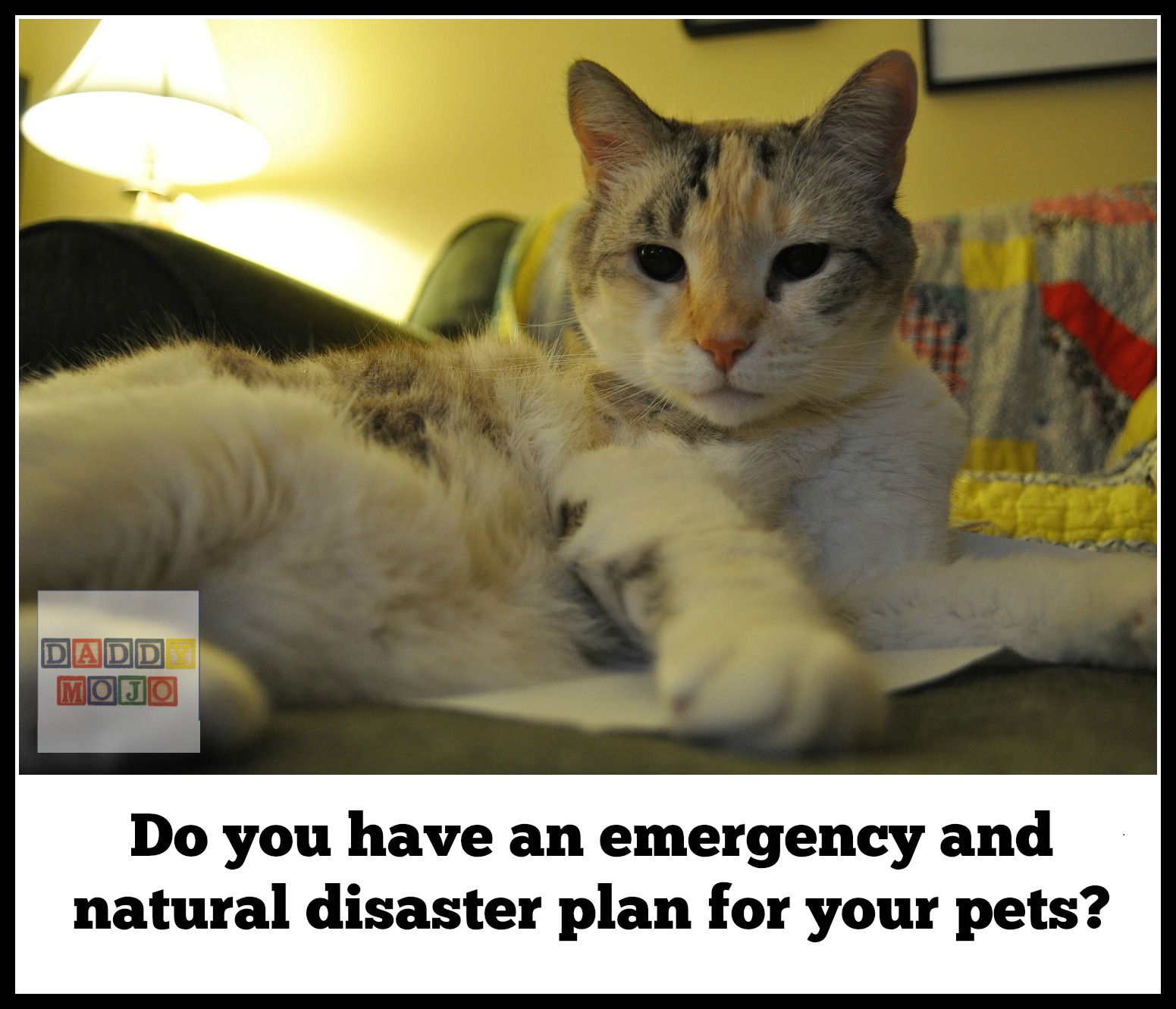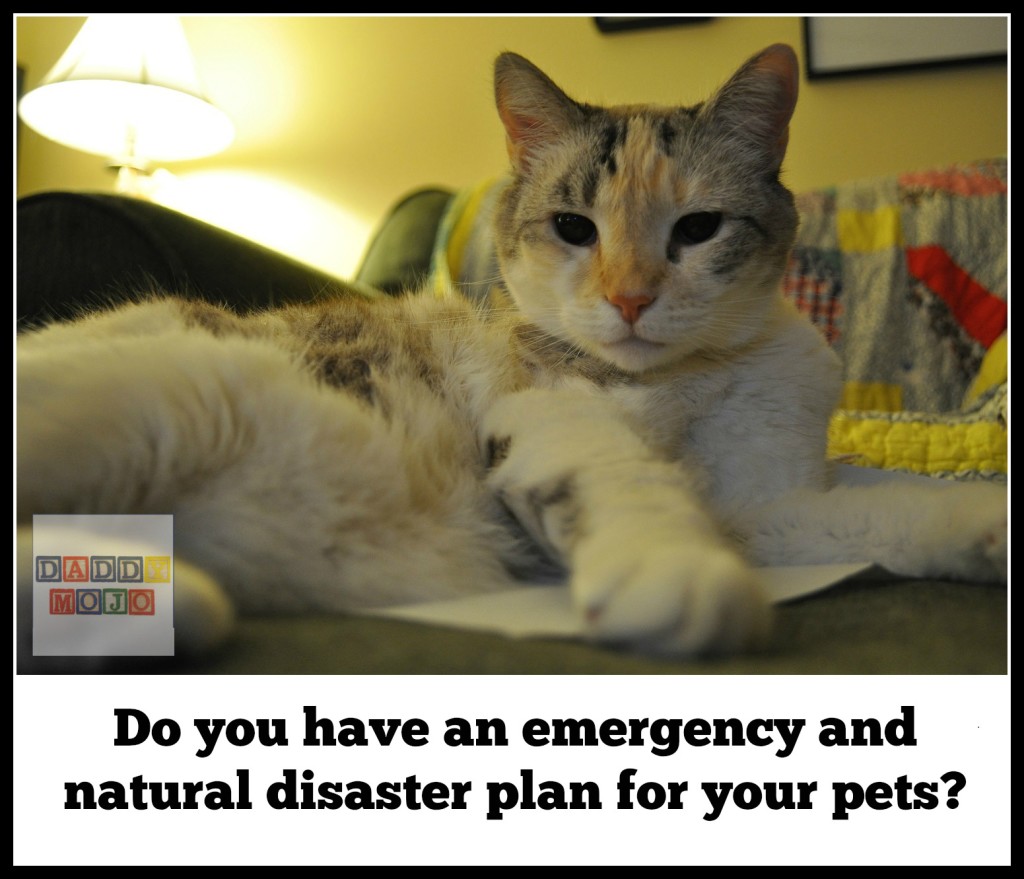This is a sponsored post. All thoughts are our own and if you’re a pet owner you really do need an emergency plan. Before being a dad and starting Daddy Mojo I worked at a large animal shelter for five years in management. When you work for a non-profit organization in management you have to know everything about the business from top to bottom. During my time there I helped the shelter deal with various disasters, both natural and man-made. In all of those instances a plan to deal with your pets, as well as, an emergency kit with their supplies was something that I did not see enough of that would’ve saved time, money and lives. October is National Animal Safety and Protection Month and here’s a brief overview of what we learned on the job.
I sat in on a phone call with Purina Veterinarian Dr. Kurt Venator and he reminded me of some things and updated figures that had changed since I left the animal welfare field. In 2012 Purina donated 4.5 million pounds of food or Tidy Cats brand litter to more than 1,100 shelters in the U.S.; that impacted over 125,000 pets. In emergency situations Purina provided 284,000 pounds of supplies to assist animals who were in the path of floods, fires, earthquakes and more. They also donated $35,000 to help the pet victims of Superstorm Sandy. How are you prepared for the unseen emergency?
Who lives in the house?
This can be the simplest thing that pet owners can do to prepare for an emergency. It could be a fire, flooding, earthquake or something else, but rescuers who come to your house will want to know how many people and pets live there. A simple window sticker that tells rescuers how many live there and who they should look for will save them time and as a result save the lives of someone else. You can get some stickers free from the ASPCA.
Is your pet micro chipped?
My pet only stays inside, there is no need to microchip them. I heard that lots of times. Micro chipping your pet is safe, does not work like ‘pet-lojack’ and is a great insurance policy to ensure that your pet finds their way home in the event that they escape or get loose. If a quick moving flood, earthquake or fire breaks the walls or your living space then all bets are off and your pet is on the run. Hint: if you go to your local humane society they can microchip your pet for much less than your veterinarian. It’s the same technology, same exact chip, just at 20% of the cost.
Your emergency or natural disaster bag
The scenes of animals being evacuated during major natural disasters like hurricane or fires happen. They’re like small children in those instances in that they’re scared, don’t know what’s going on and just want to be with the people that feed them. Especially if you live in an earthquake or area that could flood (either due to a 1,000 year flood or hurricane) you need an emergency bag for your pet.
You should pack enough canned food for seven days, first aid kit, flashlight, leash, litter tray, water, photo of your pets, cleaning wipes, a pet toy or two and a pet carrier. That’s a lot of stuff you say to yourself. And it is, but this is the worst case scenario pack that you’re grabbing when the flood waters are coming down your street, headed towards your house. It’s the bag that you hang in your garage that you run for when the bush fire jumps the line that it wasn’t supposed to jump. It may sound panicky to suggest that you need this bag, but it’s better to be prepared in the worst case.
Where are you going?
Your house is about to burn to the ground, but your pets are with you. The water is up to the first floor, but your cat in beside you in a travelling bag. Hopefully you’ve packed your natural disaster bag, but now where do you go?
All Red Cross disaster shelters accept pets. However, if it’s a major natural disaster those overfill areas may not accept pets. If you live in an area that is prone to natural disasters you need to conduct the due diligence to find out where the closest pet friendly emergency shelter is located.
If you don’t live in an area that’s prone to natural disasters you still need to find out where your pet friendly shelter is located. That 1,000 year flood is being talked about and it’s a couple of days out then do the research and figure out where you and your pets will be safe. Do not assume that your veterinarian or a boarding facility will be able to take them because they might have to find shelter for all of their animals also.
Know where the high ground is that will have shelter that can accommodate you and your pets. It could be a friend’s house in another city. Think outside of the box, especially if the natural disaster is on the scale of a hurricane or forest fire that might preclude you from going back home for weeks.
Have you checked out the complete list of disaster preparedness over at ASPCA? It’s soup to nuts what you need to know. They also sell the disaster kits for your pets and have other resources to make certain you and your best friend have it together in the worst case situation.






 Facebook
Facebook Twitter
Twitter Flickr
Flickr GooglePlus
GooglePlus Youtube
Youtube